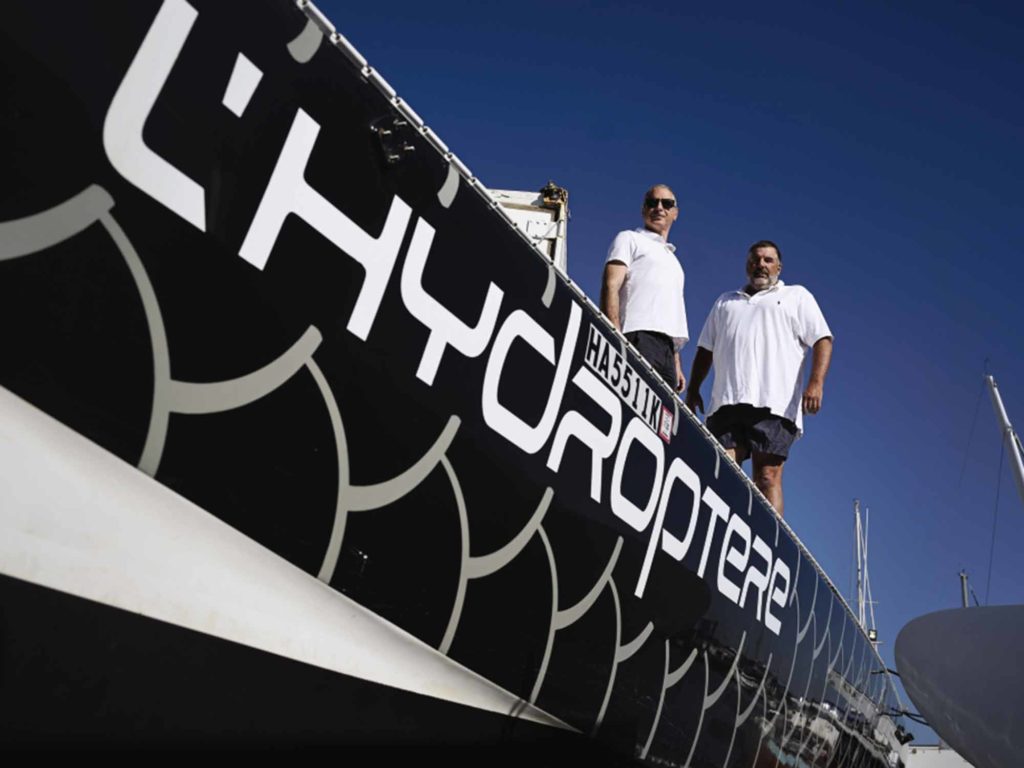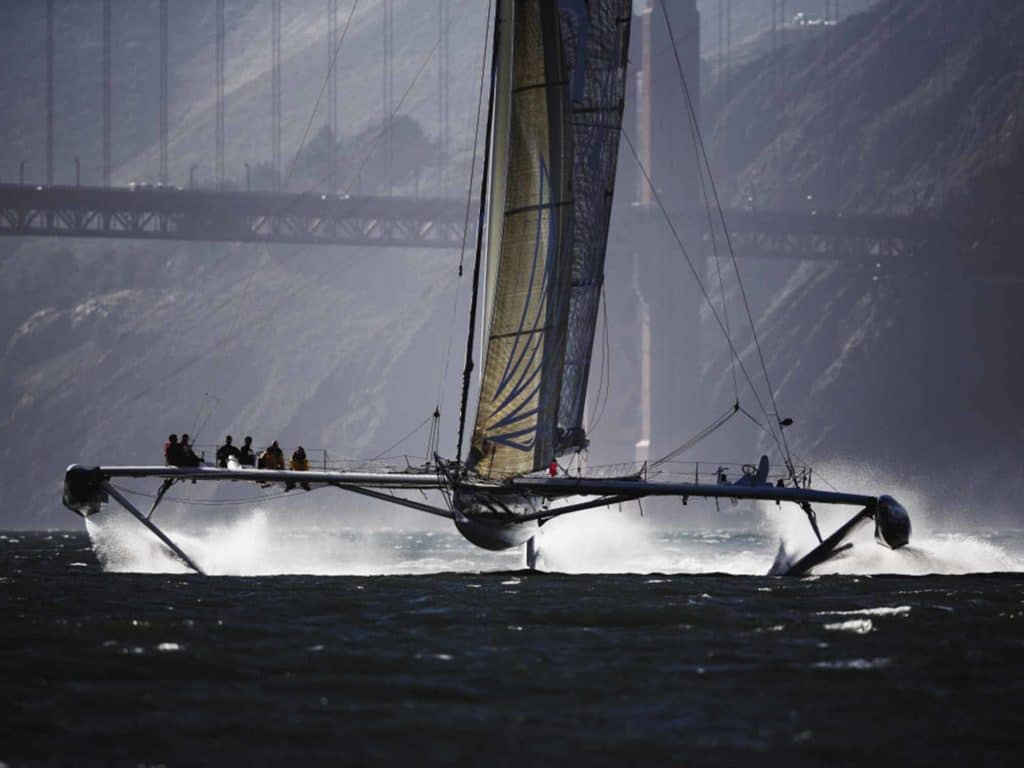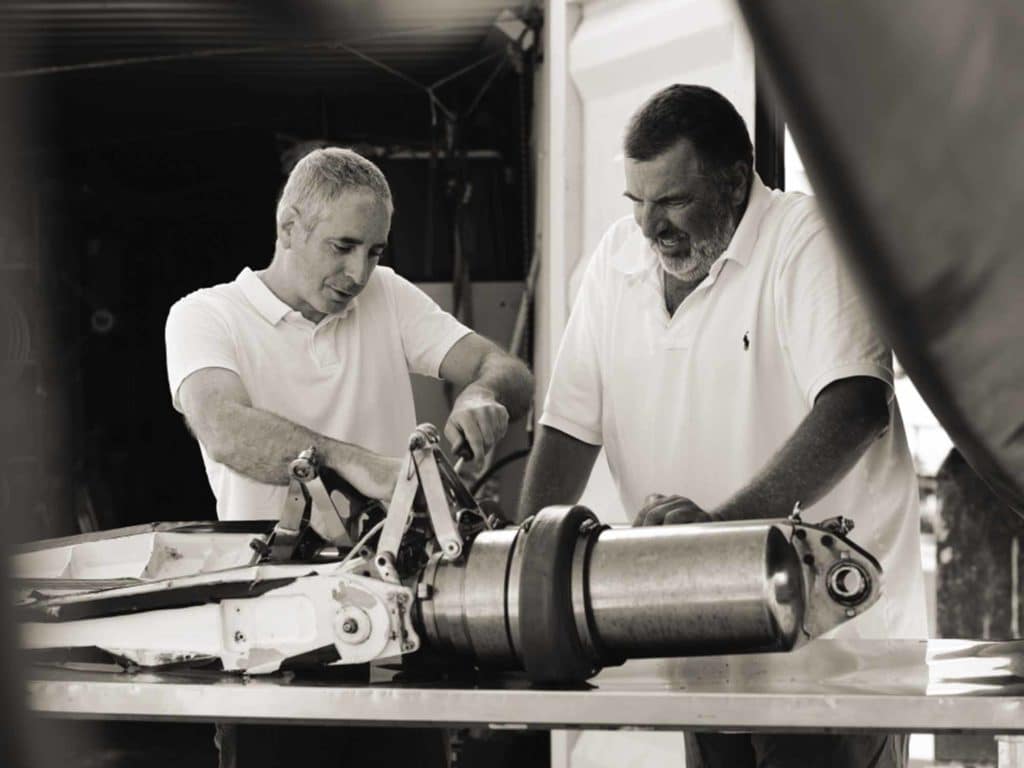
When we slowed to 22 knots, it felt like sailing in molasses. I had just driven one of the most celebrated boats in the world, L’Hydroptere, at 34 knots. Later, I’d look at 44 and try to imagine what it was like in 2009 to achieve a record-setting 500-meter run of 52.86. That one, and a nautical-mile record of 50.17 knots, were both set in France. I sailed aboard in California leading up to 2015, when this icon of French speed sailing set off on the classic Transpac course, Los Angeles to Honolulu, only to prove that the route held too many downwind miles for such a specialized machine. Unlike the even more specialized Vestas Sailrocket that eventually took its records away, L’Hydroptere could get around a racing triangle, but that would be awkward. It’s happy only on a reach. In 2015, this was no longer the fastest sailing craft ever, and there was no new Transpac record. Sponsors lost interest. The boat sat. The boat was impounded. The boat baked for five years in tropical sun and then went up for auction. What could possibly go right?
Well, L’Hydroptere’s situation could come to the attention of a true individual among West Coast sailors, Chris Welsh, who saw development potential and a future in more-manageable point-to-point records. And plenty of yoodles along the way. The choice fits his profile. For 15 years Welsh has been the owner of Ragtime, a unique, hard-chined, plywood, downwind-flying John Spencer design that has been a star—and competitive—for all of its 55 years. Ragtime is iconic in itself. No boat has sailed more Transpacs than Ragtime’s 15; few have been more successful and none more successfully updated. Its reputation, Welsh says, “hovers somewhere between revered and notorious.” When Welsh took Ragtime back to its birthplace in 2008, that was a national occasion for New Zealand. To round out Welsh’s credentials for going his own way, I’ll add that last year he bought submersible manufacturer Deep Flight out of receivership. Until COVID-19, you could find him touring Asia with one of his submarines slung between the hulls of the derigged giant catamaran Cheyenne, formerly Playstation and holder of trans-Atlantic, 24-hour and round-the-world records. The man has toys, and of course, when he flies around on the West Coast, he pilots his own. L’Hydroptere would not make sense in the hands of just anyone.
When L’Hydroptere went up for auction in 2019 in Kihei Harbor, Maui, Welsh says, “I suspected that an auction held on an island in the middle of the Pacific might not draw a lot of bidders.” He got that much right. But he was not quite alone. Enter Gabriel Terrasse, a French IT project manager who had history with the boat. Terrasse has been infatuated with L’Hydroptere since sighting a photograph at the 1997 Paris Boat Show, and he was part of the team during the glory years. He was out to save the boat “somehow—I could not let it go.”

So, what are the odds? Terrasse and Welsh sat down the night before the auction, discovered they had complementary qualifications, and agreed they would make better partners than competitors. The upfront cost was nothing compared with what it would take to get the boat sailing again, and then it would need much, much more work to become mission-ready. And Welsh (did I mention?) owns a boatyard on the shores of San Francisco Bay with a very hefty crane. Terrasse has access to all the people who had contributed to the boat’s history “as a human adventure and an engineering adventure.” They would need all of that and more.
“Before the auction, I had already made attempts to find another harbor where I would be able to work on the boat,” Terrasse says. “That proved impossible. A mooring in Kihei Harbor was going to be the best I could do, and I could see it was going to be hard, but then along came Chris. I know now that without him, it wouldn’t have been hard; it would have been a nightmare.”
Truth to tell, these two rescued each other from stepping into quicksand. The boat was nonfunctional. The main had been left on the boom “and birds were nesting in it, and of course, it was toast,” Welsh says. “At one point, Gabriel and I were sitting in the harbormaster’s office with a to-do list and a new motor waiting to be installed through a hatch that was too small for it, and they were telling us we were taking too long. They had no concept of what it means to send a boat to sea, and they just wanted this thing gone. They threatened to impound it again in 72 hours [and break it up for scrap]. Gabriel saved us by getting the French Consul involved. Thanks to the Consul and his understanding of the boat’s place in the pantheon of French sailing craft, we had a new lease on life.”
Not that working on the boat on a mooring was ever easy, nor was Maui the center of the universe when it came to shopping for L’Hydroptere parts. Terrasse spent the summer of 2019 working with Welsh’s people, and eventually the boat was ready enough for a 15-day crossing to San Francisco Bay. “She came home on a delivery main and a jib from Ragtime,” Welsh says. “With a mast 25 feet taller than Ragtime’s, that makes about a 35 percent main.” The new motor gave out with an impeller issue, so as the boat neared the coast and winds shut down, Welsh set out in his Protector with Terrasse aboard to tow L’Hydroptere to its new base in the East Bay, the boatyard known as Sugar Dock.
There in 2020 I found her again, this time in parts, a mostly-good-news story that had begun as the dream of Éric Tabarly, a man whose place among French sailors is closer to deity than mere legend. After Tabarly’s death at sea, the mantle fell to another member of the development team, Alain Thébault, to guide the project through to speed records and a legendary status of its own. “Every time L’Hydroptere was in the water, she was in the news,” Terrasse says. “Sports news. Science news.” Welsh adds: “Gabriel has done a special job of inspiring the leading figures of French sailing to align with us and care about what we’re doing. And there’s a connection. Tabarly was a boyhood hero of mine. When I won the 2008 Los Angeles to Tahiti Race with Ragtime, I was awarded the same trophy that he had won with Pen Duick III in 1972. When I had a win in the Sydney Hobart Race a year later, I was awarded the same trophy that Tabarly won in his time. It’s rather strange and wonderful.”
At the Sugar Dock, the real work got underway, providing a focus for life under pandemic lockdown. The dock has space but not enough for a complete L’Hydroptere on the hard, so the boat was dismantled in the water. The various components polished up nicely, but they did not come apart without a struggle. Welsh says: “The boat is put together with universal pin connectors. Pins hold the dog ears that lock the frame to the amas, and they were solidly corroded in place. No one five years ago imagined it would be this long before they came out. To get them out we used sledges, hydraulics, dry ice and patience —lots of patience.”
Terrasse adds, “We spent a week apiece on some of them, to not damage the boat.” Welsh continues: “They’re off-the-shelf items, so it’s no problem to replace them. The boat will go back together a lot more easily than it came apart.”
But it won’t be the same L’Hydroptere that left California for Hawaii, and that is why there’s a story to tell.
“The boat can be faster,” Terrasse says. “It’s a good platform for developing high-speed foils and for using ground effect. The AC boats are using ground effect. It’s very important to their design. “L’Hydroptere is 78 feet wide. That’s a lot to work with.” Along that line, Welsh says: “It’s 78 feet of beam—think about it. The structure has never been optimized to generate lift to take some of the weight of the boat. It’s just been pushed through the air.”
Going forward, there are two levels of ambition. First, Welsh says, “I just want to go sailing.” To make that happen with a set of faster features that can be mustered by “mere mortals,” Welsh and Terrasse intend to start with aerodynamics: fairing the beams, housing the crew in bobsled-style cockpits, and improving efficiencies aloft by adding 3D sails. Perhaps that means hard sails, perhaps inflated sails, perhaps sleeving the mast. There’s a lot to ponder, but with that much done, Welsh believes, the boat will be ready for point-to-point record attempts.
Beyond that, and this is where Terrasse really lights up, L’Hydroptere could be a platform for pushing the envelope. The possibilities are dazzling to anyone susceptible to an engineering adventure, but how quickly these things come, or if at all, will depend upon sponsorship. Suddenly we’re talking in-depth research, high-end fabrication, and money to support the project through risks of failure. CAD simulation has come a long way since the boat’s early breakages, but bleeding edges tend to bleed.

It’s a tantalizing prospect, for example, to imagine incorporating super-cavitating foils to operate in the realm above 50 knots, where standard foils develop vapor-inducing low pressure and lose their bite. The concept has been around for decades and applied in high-speed propellers, but a sailing hydrofoil would have to transition from a shape that develops lift on one surface (at lower speeds) to the opposite surface (at higher speeds). There has been plenty of technical speculation on how to accomplish that, but no one has solved it at a practical level. Terrasse and Welsh have ideas specific to L’Hydroptere—but. Before tackling super-cavitating foils, it would be expensive but not hard to build lighter passive foils with lower drag than the existing passive foils that, frankly, are Jurassic leftovers. It would be even more expensive, and harder, to try actively managed T-foils, and then fly-by-wire. Terrasse says, “Maybe we should build a wing for pure speed work and keep this rig for offshore sailing.” And modify it for active canting and…
Dreamers gotta dream. First, simplify things and just go sailing. Frozen pins were not the only challenge in disassembly. There were mysteries. “We relied on Gabriel and his connections,” Welsh says. “We’d be doing something by day, and he’d be doing research by night, chasing answers as to how the next thing came apart, maybe coming up with drawings because he knows the people. The critical path is the overhaul of the struts. They’re built like aircraft parts. They’re aluminum, titanium and carbon fiber, and we’ll rebuild mostly as-is but with better aerodynamics. Redesigning for ground effect—we can save that for later.”
There’s a chance L’Hydroptere could be sailing by winter, and whether it is or not, one unknown is where. In California, Welsh figures, the boat could make it from San Francisco to Los Angeles in 10 to 11 hours by picking a weather window. “And we could probably do the Newport to Ensenada Race in two and a half hours, but we might have to sail 50 races before we got ‘that’ day. I don’t know if the boat will stay in California long enough for any of that. If we get a sponsor who’s interested, we’ll go to the America’s Cup in New Zealand and fly on the Waitemata when the wind exceeds the limit for the AC75s. As much as anybody, I miss the chess match of the keeled monohulls, but today’s unbridled advancements are fascinating. I’ve already told you we want to turn the fuselage into a wing, and that development is very much in play at the next AC—how the fuselages deal with drag and ground effect. That’s going to determine this Cup match, not the foils.
“L’Hydroptere has a future with or without sponsorship,” Welsh says, “and with or without going to Auckland. Eventually the boat belongs in Europe, again, hunting point-to-point records in the Med and maybe looking for a 24-hour record. It’s startling how much response Gabriel has received. In America there might be a thousand people who know L’Hydroptere. In France there might be a thousand people who don’t.”
One question hangs in the air: What would Tabarly do?









